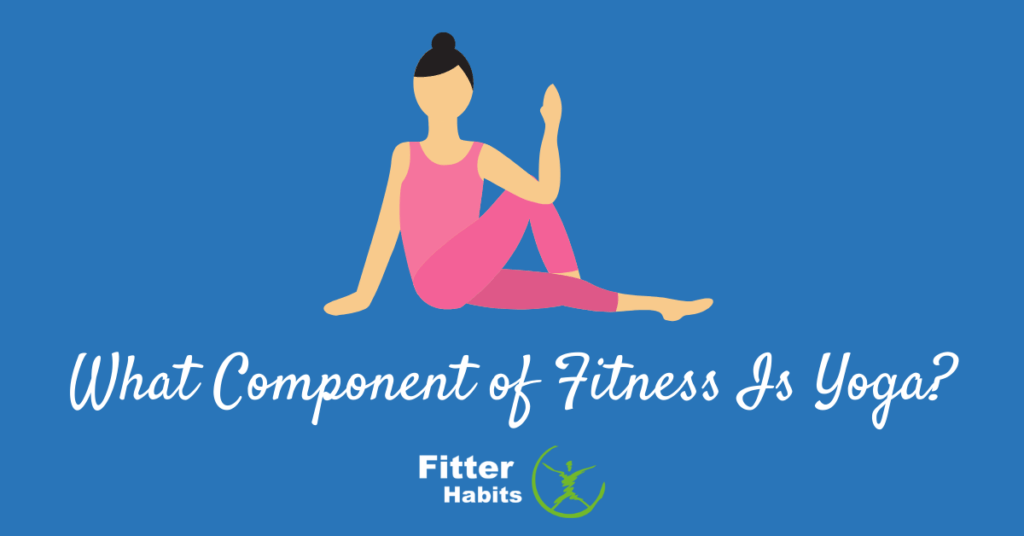Yoga can be part of a healthy fitness routine. What component of fitness is yoga? Here’s how it fits numerous components.
I don’t know about you, but I don’t always want to exercise. It can feel so forced, like a chore. But I find it helps to think about fitness from a different perspective.
The key was for me to break my association with gym class and find some kind of exercise I actually enjoy, which turned out to be yoga. Yoga is more than physical, as it incorporates a focus on mind and spirit as well, yet it can definitely be counted as a type of fitness. And it’s something I enjoy, so it helps me fit fitness into my life in a way that works for me.
You might wonder if yoga really counts as fitness–I say the answer is yes! So what component of fitness is yoga? Depending on the type of class, it can actually fit multiple components—that’s a win to me!
Contents
What Are Fitness Components?

Whenever fitness comes to mind, I think of something like running or swimming. After that, I might think of muscled men competing over how much weight they can lift in the gym. Do you think the same way?
Sure, these are aspects of fitness, but they don’t make up the whole story. Fitness encompasses a broad range of physical activities. It can include dancing, stretching, doing push-ups, walking, and a long list of other activities… even sex!
Basically, I learned that the goal isn’t about the type of exercise you do but more about incorporating numerous fitness components into your life. The main components are moderate to intense aerobics and muscle-strengthening activity, which are the focus of the Physical Activity Guidelines for Americans (2nd edition) by the Department of Health and Human Services.
Then, it can be broken down further. The American College of Sports Medicine (ACSM) gives five physical fitness components in its ACSM’s Health-Related Physical Fitness Manual (5th edition):
- Body composition
- Muscular strength
- Muscular endurance
- Flexibility
- Cardiorespiratory fitness
I know a lot of people don’t take yoga seriously as a legitimate form of exercise, but it can incorporate all or most of these fitness components. I’ll tell you how.
How Does Yoga Fit into Fitness Components?
I’m going to break things down slightly differently than the fitness guidelines because I find them a little technical, but you’ll see how it all relates. In general, I want to talk about how yoga provides aerobic/cardio fitness, strength training, and stretching all in one program. These aspects help you fit numerous components on the more technical list.
Aerobic/Cardio Fitness
Basically, this is that heart-pumping type of exercise. Guidelines recommend engaging in moderate to intense levels of cardio or aerobic exercise, but they also recognize that any level and amount of movement is better than none.
Yoga is often associated with gentle movements, sitting still and lying down. Sure, these can be aspects of yoga. But it can also get you moving with more intensity.
There are different types of yoga, and some get you moving more vigorously: flow yoga that moves from one pose to the next, power yoga with a focus on intensity, and hot yoga that encourages a lot more movement in high heat, getting the heart pumping. Also, doing any active yoga poses in any type of session can fit the category of engaging in movement rather than sitting on the couch.
What’s my point? Moving your body into yoga poses and going through a series of poses, which is typical of any yoga session, can help you meet that aerobic/cardiorespiratory component of fitness. And more vigorous types of yoga help you reach the moderate to intense level.
I’m also going to add the component of body composition here. The goal for a healthy body is to have a body composition made up of less fat and more mass-like muscle. Moving from pose to pose in yoga can help burn calories and increase strength to support healthy body composition.
Strength Training
Most yoga poses provide strength training through bodyweight resistance. This means you’re strengthening your muscles with the weight of your own body rather than through outside means like weights or machines. For example, a yoga pose may put you into a squat or lunge position, which is working muscle as you hold the pose.
In case I’m not being clear enough, this aspect of yoga will help you reach the muscular strength component of a fitness regimen.
Muscular endurance is another component that yoga can help with as well. This aspect is about repeating strengthening movements for long periods of time in a slow, controlled way.
Many yoga classes have you go through series of the same poses and hold each pose throughout a class that lasts for an hour or more, which I would say creates the conditions to encourage muscular endurance.
The strength-training aspect of yoga also helps toward a healthy body composition. It contributes to non-fat body mass, and muscle can help burn fat even when you’re at rest.
Stretching
I probably don’t have to tell you that stretching is a part of yoga. But I’m going to anyway just so I can relate it to the flexibility component of fitness. Consistently stretching muscles and holding the stretch can boost flexibility and range of motion.
Yoga can definitely provide this benefit, as most yoga classes will have you stretch muscles throughout your body—some I didn’t even know I had until yoga forced me to stretch them. Yoga gets me into positions on the floor, standing and upside-down, helping me stretch in every way possible.
The Final Word on What Component of Fitness Is Yoga
I hope I was successful in showing that yoga can contribute to all components of fitness: healthy body composition, muscular strength, muscular endurance, flexibility and cardiorespiratory fitness. The benefits vary by the type of yoga class, but most classes will at least provide some of these components. Some types provide all of them.
And then, I can always combine yoga with other exercise to get all components.



